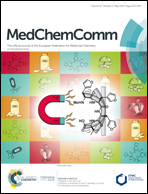Design, synthesis, and antimicrobial evaluation of 1,4-dihydroindeno[1,2-c]pyrazole tethered carbohydrazide hybrids: exploring their in silico ADMET, ergosterol inhibition and ROS inducing potential†
Abstract
A series of new 1,4-dihydroindeno[1,2-c]pyrazole tethered carbohydrazide hybrids (5a–u) were designed, synthesized and evaluated for their antimicrobial activity. Compounds 5d, 5g, 5j, 5k and 5q demonstrated significant activity against the entire panel of test pathogens. Further, compounds 5d and 5g exhibited significant anti-Candida activity. These potential hybrids (5d and 5g) also exhibited promising ergosterol biosynthesis inhibition against Candida albicans, which was further validated through molecular docking studies. Furthermore, compounds 5d and 5g caused intracellular ROS accumulation in C. albicans MTCC 3017 and were non-toxic to normal human lung cell line MRC5. In silico studies revealed that they demonstrated drug likeness and an appreciable pharmacokinetic profile. Overall, the findings demonstrate that 5d and 5g may be considered as promising leads for further development of new antifungal drugs.
![Graphical abstract: Design, synthesis, and antimicrobial evaluation of 1,4-dihydroindeno[1,2-c]pyrazole tethered carbohydrazide hybrids: exploring their in silico ADMET, ergosterol inhibition and ROS inducing potential](/en/Image/Get?imageInfo.ImageType=GA&imageInfo.ImageIdentifier.ManuscriptID=C9MD00155G&imageInfo.ImageIdentifier.Year=2019)


 Please wait while we load your content...
Please wait while we load your content...